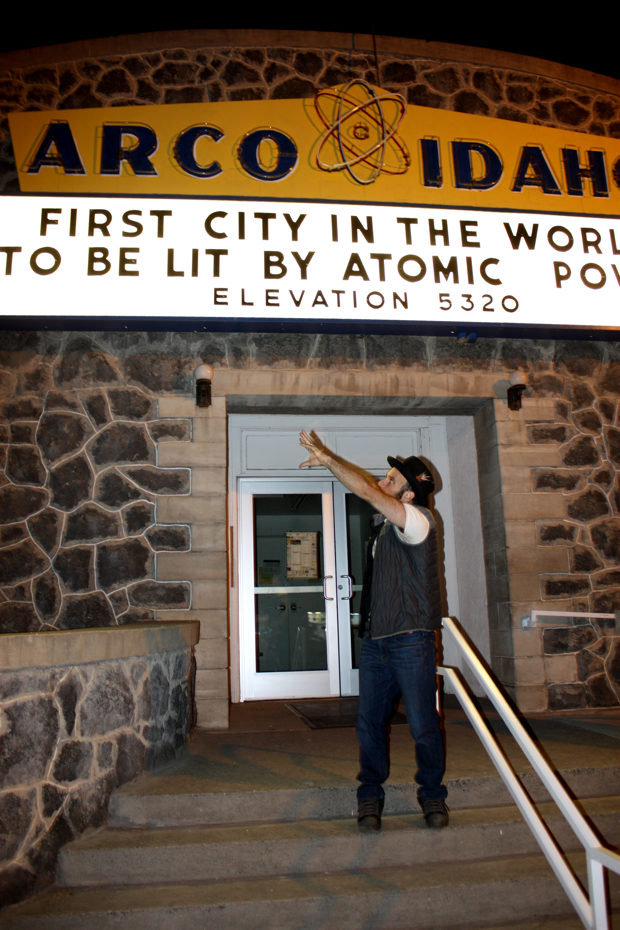
The following is a true story… prose by Ryan Ariano… photos by Borbay…
Its a disturbing thought, that somewhere in the Idaho high desert lurks a nuclear submarine, carrying the mark of the beast on its fin and the skeletons of Kruschev, Einstein, Oppenheimer, a forgotten city named Arco and a forgotten man named Zinn in its buried gut. For now the devil sub is frozen under moongrass, a small but vital relief for the burger joint standing at its bow. But you never know if, once the city has returned to dust and the vast Idaho winds have unearthed the great hulking corpse, it will set sail through the loam and finally off into the atomic sunset that had been promised here so long ago.
The Borbax Reactor
New obsession want to check this crazy town out with me sometime in the next week? the text read. It was a link to a picture of river rock golf ball of a city hall boasting the fact that Arco, Idaho, was the first city powered by nuclear energy. A neon daydream from Borbay, accompanied by other pictures of a hillside flecked with numbers and a sign with an outline of a green Idaho against a brown backdrop broadcasting Atoms For Peace.
The atomic age is the culmination of evolution, I replied.
Exactly 5 days later were tooling down ID-26 as the sun ripples the end of the road with rainbow drapery, sitting on a 6-pack of PBR tallies and a chunk of obsidian with a small tab of candy-coated paper Id just cut in two with a camouflage lockback pocket knife from a wildlife park in Rexburg.
This all started with Borax-III. It was little more than a publicity stunt, an act of scientific ingenuity engineered solely to combat Soviet propaganda.
Borax III came after Borax I and II, of course, two earlier experiments in which they tested whether rods undergoing the heat-generating act of fission could safely turn water into steam and whether that steam could then be used to turn a turbine. This was the cutting edge, to fuel something as massive as a city with something as small as an atom and a response to Soviet claims that the only use for nuclear energy was scorching earth and powering military vehicles, swift silent deep indeed. This was mans greatest achievement, or foulest usurpation of divine power; as Oppenheimer so famously quipped, What hath God wrought? The kind of creation that can only be executed in the endless expanses of manifest destiny.
Borbays new to life out west. From Manhattan to Eastern Idaho might as well be a trip to the moon. Which it is; Craters of the Moon National Park is right around the corner from our destination, a must-see went all the comments and tourist guides. But were not there to amble around some pockmarked desert park during the day. Were there to glimpse neon radioactive dreams in the womb of the pitch black high desert night. But at this moment, Borbay is marveling at the darkness.
I wasnt used to the darkness at first either. There are very few stretches back east so infinitely empty. Especially disorienting if youre from the Mid-Atlantic, where large open expanses between islands of light usually mean a body of water of some sort. Especially disorienting if youre an artist currently flashing through a neon kick, like Borbay. My half of candy paper was gone.
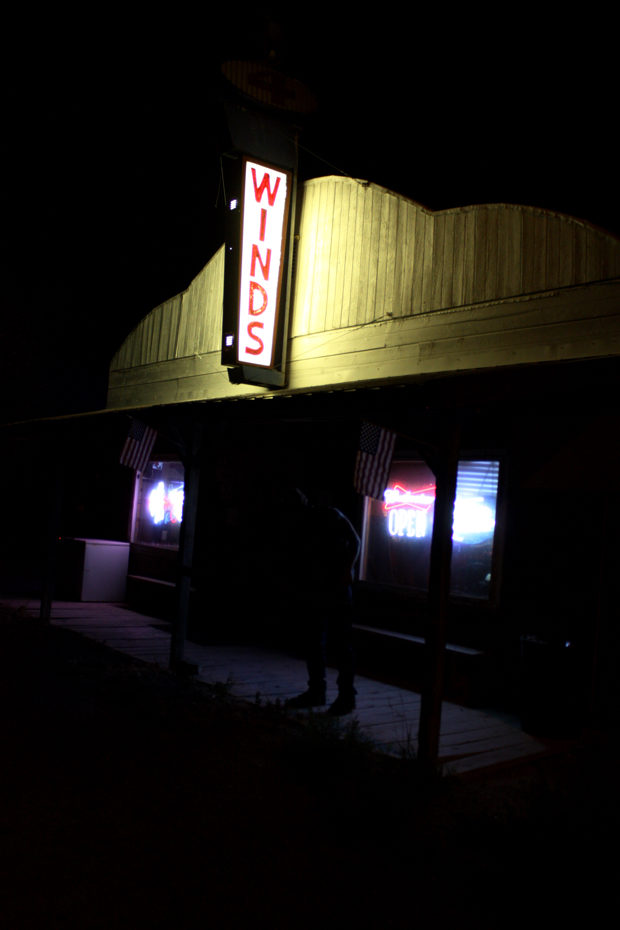
Our empty crossing of the desert ocean of night ends at the Four Winds, a roadhouse with Winds still illuminating the night sky and the oval above it holding the 4 a burned-out tube.
Ive lived everywhere. Oregon. Alaska. San Diego for a little bit.
The bartendress is talking, a desert Sweet Dee after her eventual exile from The Gang, with enough meat to keep warm through the cold, harsh Idaho winter.
San Diego, I used to live there. Where were you?
Well my brother was stationed there and I just lived at his place in Oceanside. It was nice. But when he got moved, well, so did I.
Camp Pendleton, huh? So whyd you settle here?
I dont know. Just, you know, found myself here, with a man, worked at INL, down the street. You just kinda get stuck here.
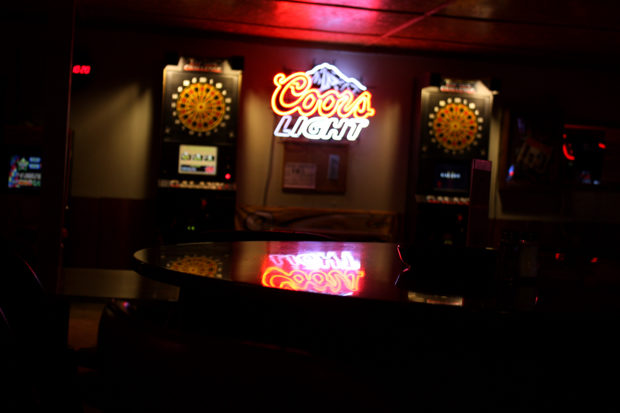
I nod as Borbay makes his way around, snapping pictures of something only he sees amid the neon liquor signs and cheap Mardi Gras beads and an empty stage. Ive always preferred to post up on the bar, where I am solo until Borbay returns to cheer the rotgut Id ordered. Then I sip my Natty Light backer, zoning in on pre-season football on the floating television. Two eyes stare at my back, whites shot with bloodshot triangles pointing to bullseye pupils. A nose of a neon Coors Light splits them neatly.
Whos your team?
The Colts.
You from Indianapolis?
No, I just grew up cheering for them.
How about you?
Im a Seahawks fan. Lived in Washington for a bit.
Washington, I love it up there. What brought you here?
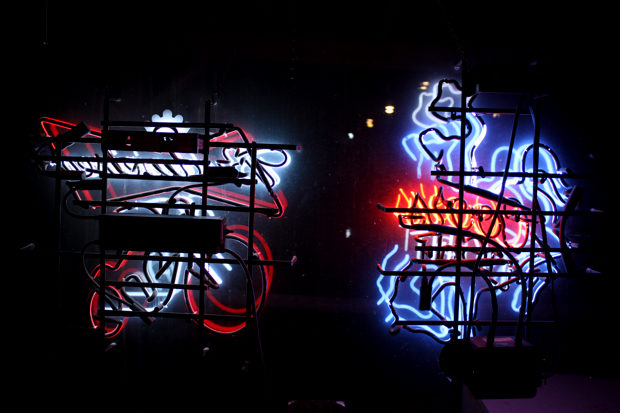
The man at the end of the bar mostly smiles softly in the shadows, a thin, clean-cut city kid returned to his forgotten kingdom.
His parents own the place.
Borbay is sitting at the bar, doing a sketch of two dartboards split by a Coors sign. Its the least depressing empty bar Ive ever been to. I look up; the ceiling above us is littered with dollar bills with names signed to them.
Whats that?
I dont know how it started. People stop by and sign dollar bills. We collect them all up there.
I had expected the rowdies to be out. At least a few others; this was a roadhouse after all, hell, bring on drunken bikers throwing bottles of Miller Lite at the wall. But instead its me and Borbay, and the bartendress whod been everywhere and found herself nowhere, and the owners son, and a stage of frozen musical instruments.
You have music here?
Sometimes but it costs too much. Dont get the business to do it.
Sure.
So what should we check out?
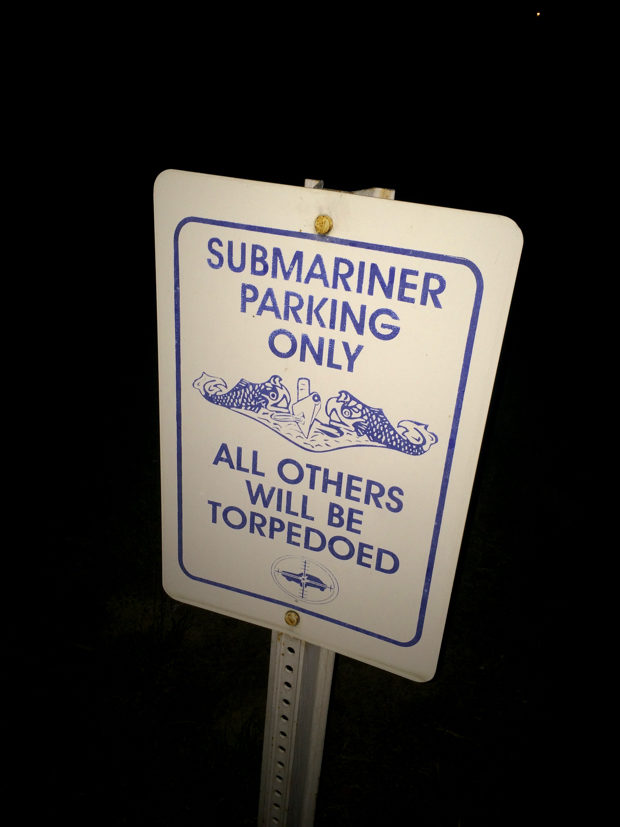
The submarine.
Yup, definitely. What about EBR-1. Wheres that?
Oh, back down that road a ways. There are signs. And you definitely should go check out Craters of the Moon.
We finish our beers and Borbay hands them the sketch hed been drawing and I mumble something about them keeping it since he sells paintings for a lot and then were back on the road running hot.
We should explore that submarine.
Yeah but first we should get some food in you.
No, nothings open at this hour, Ill just keep running on what Ive got.
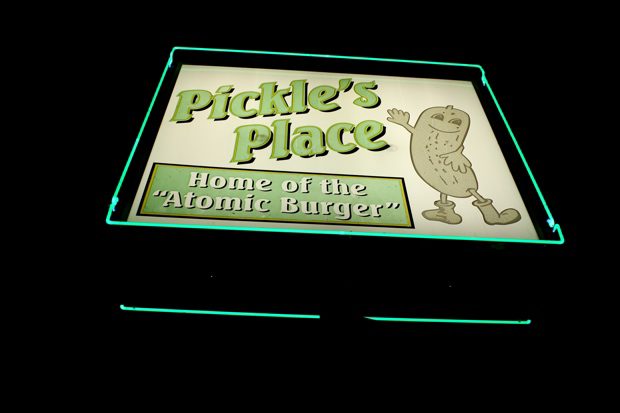
At the south end of the town of Arco proper stands a burger shack named Pickles. Wed both heard about it. The lights still on and the door still opens; the great atom has swayed its orbit wide enough for me to grab one of Pickles world famous Atomic Burgers.
Pickles has stools against a counter and a concrete division on the floor denoting the add-on from its former life as the food stand for a long-deceased drive-in. The last picture show made into a burger stand. I sit at the table, eating my burger, refueling as only creatures too weak to tap into the near-endless promise of atomic energy must.
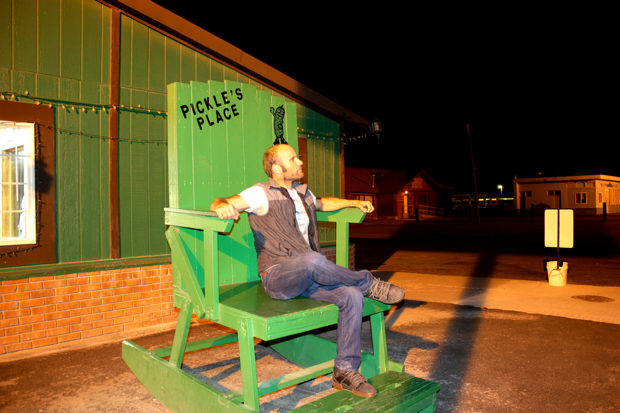
Americana Revisited
This town is as American as it gets, a former silver screen pinup. In a past life it was an explosive cinema verite staged for the sake of the battle against communism despite the inherent threat to the poor bastards who lived there. An open set propaganda piece orchestrated by the most brilliant physicists on the US governments payroll. Arco, Idaho, was the first city ever powered by nuclear energy, a much-lauded victory over Soviet atomic encroachment and the fulfillment of our American dream of eternity.
Yeah we had our fifteen minutes of fame, the counter girl said. Literally 15 minutes. That was how long the power lasted.
She wore sun-bleached hair pulled back tight over tan skin and a strong frame, a farm girl moved inside for her nighttime side gig.
They make their own spice, shes telling me. It tastes like Old Bay with an extra kick. That and a burger and fries and a Bud Light. I give the woman a 20 and smile, unable to grok the actual price so I have no idea if she gave me correct change. She tells us about the old drive-in and how the nickname of the wife of the first guy to turn it into a full-time burger joint was Pickles. She tells us that the sons of the current owners play guitar and drums for the local band, Voltz, the biggest act in town. Once Ive eaten I ask her about the submarine. She takes us out front and points across the street to a dark park and tells us that right where shes pointing sits
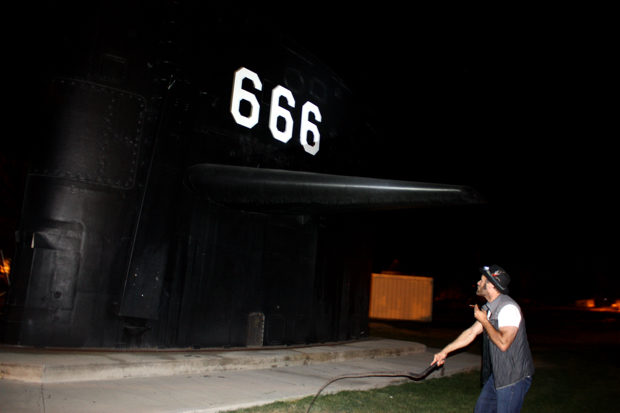
number 666. To some people thats a bad sign, mark of the devil. But other people think its good luck. I mean, the sub made it through the war, right?
We thank her and pay and drive across the street to park in front of a sign that says Submarine Parking and walk onto the grass to rap the flat black iron fin.
The USS Hawkbill was called The Devil Boat. It launched from Manitowoc, WI, the county best known now as home to Steven Avery, the protagonist of season one of Making A Murderer.
She went to the Phillippines. Her first true prey was the Momo, a Japanese destroyer, taken down with 6 torpedoes to the heart. Escaped a firefight in a strait by disappearing into a squall. Came back to sink two sub chasers. Got pummeled by depth charges and had to sneak away severely damaged. Got repairs and went to Bali where she damaged a minelayer, then blasted it in two as it was being towed to shore. Returned to battle one more time to take out a few radio stations and drop off commandos. She retired from WWII with 6 Battle Stars. She was later lent to the Netherlands.
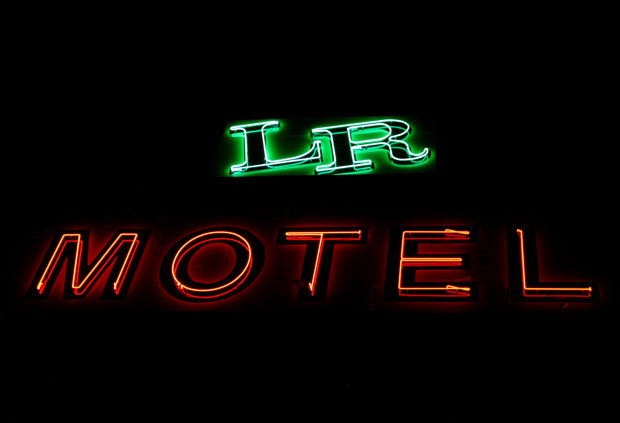
I imagine her hundreds of feet deep, under the crushing salty black. I think of my old roommate, a nuclear tech who told me about seeing the sun only once every few months. I think about madness and claustrophobia in this living movie set of finely-manicured green grass with a conning tower prop permanently dug into the soil and right next to it the Lost River motor inn adorned with big flashy Christmas tree bulbs and a soaring neon sign announcing LR for all the world. The rooms are a centipede of 1950s cottages in alternating pastels. No doubt this building grew from the great seed of the atomic age.
Did the devil ever catch Robert Johnson? Maybe he figured a way out. Maybe the devil just gave him the tools but the music he created was so beautiful the good side claimed him back. Dark submarine 666, Borbay says into my tape recorder. On re-listen it slows into a deep voice of the diablo, the tape stops, spits, and I hear something about claw front.
I need to see city hall.
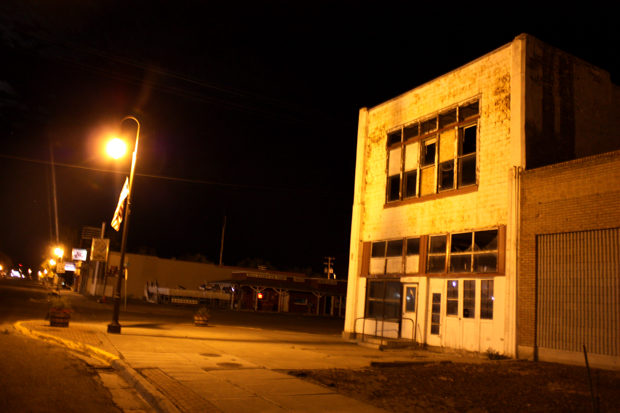
Downtownies…
…and a warehouse thats empty, maybe it will always be empty, except for ghosts, goes the recording of our night.
A half golfball screams to us across the street from the masonic husks: Arco ID – First city in the world to be lit by atomic power. Elevation 5320 and as we get closer it becomes a river-rock concrete adobe. Borbay takes pictures while I collect my wits. Its 11:30. I have to be back at work at 9 tomorrow. Not a single light on in any building, not even a hint that anybody lives here but chiselers and atomic mutants and sage grouse.
You know, all it would take would be some hipsters moving in here and they could redo this whole strip. Fusion food joint here. Art-work space in that abandoned brick building across the street. Borbay is a creator.
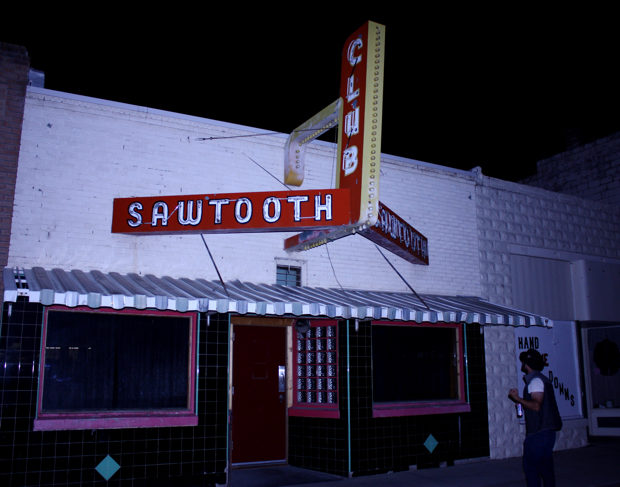
Lets drive down Main Street. See if anybodys decent at this hour. Im a searcher.
A billboard invites us to Lost River Found and then were confronted by a bright neon sign with an arrow pointing at the Melo-Dee Club Bar and Steakhouse, a human mosquito zapper. Follow the glowing gas tubes to a concrete rectangle an empty parking lot away.
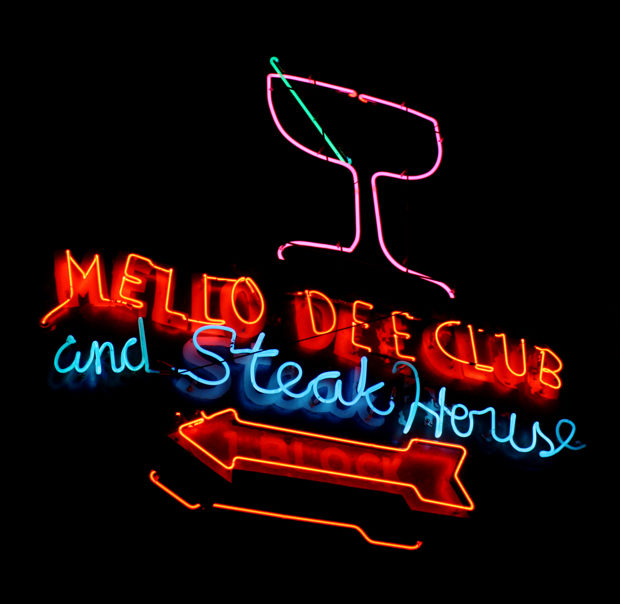
And the still night explodes with the laughter of 8 men and 2 women and a jukebox blasting Staind. Take my place at the bar, the only place for two weirdos like ourselves. Everybody else here wears dark nondescript hoodies and jeans and shirts and have big scraggly beards, the breed of men who excel at hunting but do nothing the other 9 months of the year. Maybe fish and snowmobile. Borbay has on a Christmas sweater and a fedora.
Im in the past now. In a bar with Polaroids taped to the mirror and bottles weighted down by dust and the Idaho version of a Baltimore hon behind the bar, long limbs sinewy and full of energy, asks us what we want.
Hey guys.
We spin around and theres Sweet Dee, surrounded by 3 guys. The youngest with the jet black hair the dark eyes, built like a lineman, theyre all built like linemen but hes clearly the young alpha; this young man is paying special attention to her and looks at me wondering who the fuck am I that I know her.
Oh hey, I thought you were working at the other place?
We closed for the night. I came here.
Thats all she says to us as I nod and we turn back to sip our beers on the wooden bar.
Whats that? I ask the woman behind the counter.
Oh that bottle? I don know, owner musta brought it back from Italy long time ago.
Can we have some? A double-magnum of Fernet Branca tints the mirror behind it yellow.
No, aint been nothin you can drink in that long as I can remember.
The steakhouse is the other side of the club. Its closed now. This is no time for feast anyway. This is time for drink.
Actually its time to head home. On our way out, I ask the woman who she thinks people around here are voting for, the political junky in me.
I dont know. I think most people are voting for Trump.
Whys that?
I dunno. I guess most people want a change. And want somebody tellin the truth.
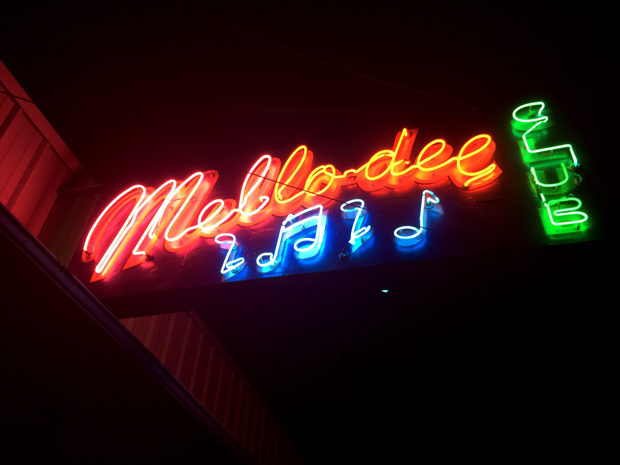
The Last Stop
Yes, the world has changed. And Arco is what happens to the things left behind after the apocheir, for that is a mighty high peak, no matter how briefly. So we have to see it, the place where the whole thing started. The laboratory.
Were back in the edge of the desert looking for ground zero.
The first lab was a study in a controlled nuclear reaction. The heat that comes off a plutonium rod. Then the Borax experiments. Nuclear energy is raw. The nuclear reaction creates unimaginable heat with little extra input. That PU-239 rod burning at unfathomable temperatures with a sodium cut is inserted into a watery vat and the steam turns a turbine. And Borax I tested whether water could be heated and contained and Borax II tested how far you could push it before it melted. Borax III powered the city of Arco for 15 minutes.
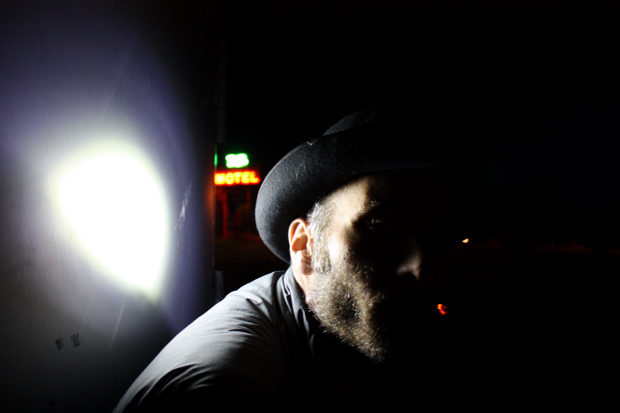
It was 1955. There was an international nuclear summit in Switzerland. Everybody participated except the U.S. and Russia. They were playing their cards close to the vest while the rest of the world went fish. But Russia had said there was no application for atomic energy except in weapons: bombs, submarines. Americas greatest wanted to prove those Soviet bastards were a step behind so they rushed forward the half-cocked scheme of lighting a city. They chose a city far enough in the middle of nowhere that if something went hideously wrong, the casualties would be few. Most of America would hear about it as a feature story on the news, maybe, maybe, and it would go down in the history books as a tragedy and everybody would move on.
The lab is known for another first. The first nuclear meltdown in America. And the only fatal one on US soil. There is no sign advertising this. Nobody spoke about it as we asked like no doubt millions before us have. And the submarine was another reminder of the Russians position, that nuclear reactions are only useful for killing. But thats way too simple. Nuclear energy is like rage. A fuel unmatched by any other. But if left uncontrolled, it quickly can drive all of us to our destruction.
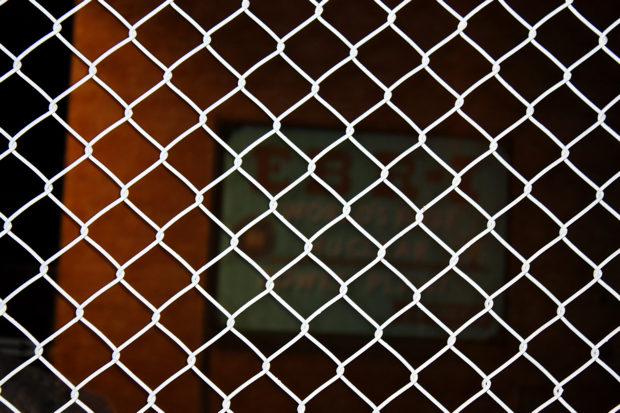
Experimental Breeder Reactor I, or EBR-I, is a blank white rectangle two tall stories high. There are no cars parked on the other side of the barbed wire. One stand-up paper shaded light glows through the window.
Follow the fence to the big machines with gaskets the size of shower curtains and tubes and pumps, a steampunk wet dream emerging from the darkness. Two monoliths to the moment when man thought hed finally beaten God.
The engines are test units for a nuclear-powered airplane program, says the cloudy Formica tablet the little hut next to it. The experiment never worked out. This was the first step towards rockets. And nuclear propulsion is being proposed as the fastest way to get a robot to the other planet that is promisingly earthlike. Four light years. The nuclear pulse engine could get a robot there in 100 of our years. And in half a millennium we might have a colony there. Or they could colonize us. And this may take on importance many of our monuments to politicians and celebrities do not. Except for Rocky: Hell be mythology in the future; to tear down a statue of Rocky in the Old Philadelphia would be like crushing a statue of Hercules in Athens.
HTRE-3 and HTRE-1 were supposed to keep the Convair X-6, a plane 162 feet long with a wingspan of 230 feet, in the air for weeks at a time. The big B-52 bomber was 159 feet long with a wingspan of 185 feet. HTRE-3 was the only one ever allowed to reach full power. It only ran for about four minutes, though, because it launched nuclear particles out the exhaust that contaminated about 20,000 acres of the Idaho desert. After that, the whole thing was scrapped. Now the only reminder for most people of billions of dollars and countless man-hours are two inert husks planted innocently in the Idaho desert. And the INL, of course. But thats another story.
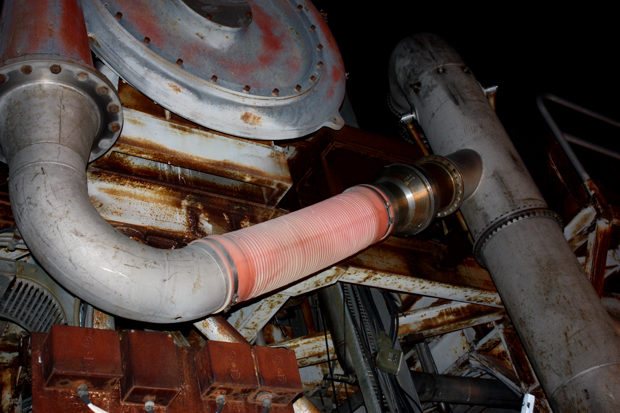
Its late. 1:30. Time to go home. I grab a porous, light rock from the base of the barbwire fences, for my son. Energy leaves my body and even the nicotine in my lip does little to fight the great melancholy once we start off.
We drive towards the light, through the ghost town of Atomic City to Blackfoot, then back through IF and home. We speak few words and those are Rockulean efforts on my part. Im reminded of the drive back from climbing Mt. Rainier to our hotel in Alki Beach with the novelist Steve John behind the wheel. The other two were asleep. I struggled to stay awake as he powered into the night. That ended with beers and showers and 4 pizzas eaten while watching the Olympics from under bleached sheets. This trip would end at Borbays dark-wood palace on the 18th green. I was fully sober by this point. Tapping into the reserves Id discovered in the first nine months of fatherhood. Driving down the main street, then down Cedron to my own home in the valley between the Tetons and the Big Holes. To my nuclear family. In a city changing from ranchers and homesteaders to millennials and Gen-Xers looking to turn the ranges into mountain bike trails and stand atop peaks the settlers had been content to gaze up at.
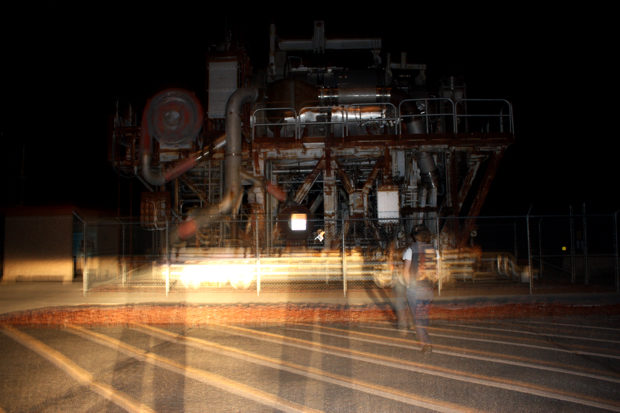
The Change
Things change, thats the only constant. And the center of life is always left behind and every iteration of that center erases the America before.
Borbay and I had seen a place that for a few moments was the pinnacle of the evolution of the human mind. From the stone arrowheads of obsidian you still find near where I live, we learned how to harness the energy from the most basic element of all existence.
At home in my farmhouse, I fall asleep to the wind that blows hard from the West, from Arco, to remind us we will never reach that bright pinnacle; that we may reach the false summit but we have not reached the top of the mountain and maybe we never will; maybe evolution is just a series of false summits until it all crumbles beneath us in one great seismic shift.
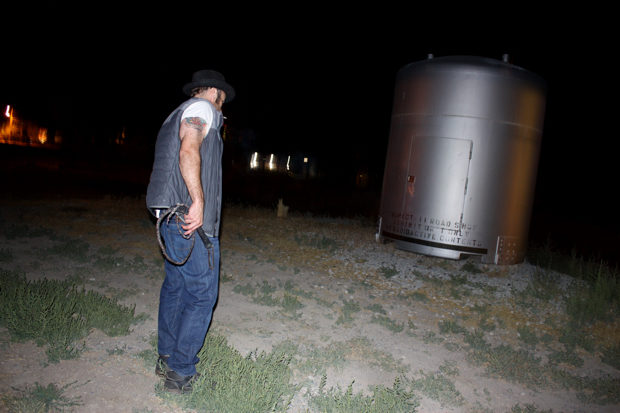
Arco has changed from its brief seat at the top of the world as evidence of the greatness of man to a quirky roadside stop with a story any rural city would envy. This was where we thought the mountain peaked, where all of our great dreams surely became real. And just as surely we continued onward and upward. Still, what it left behind is no less important because history has moved on, no, goddammit. Every step is worthy of eternal valor. And Arco, Idaho, population 910, elevation 5320, was one of the great steps. And from such great heights of a false summit spire, some amazing atomic blossoms have bloomed. Neon nuclear dreams us mortals can only aspire towards.
I for one will dream of a devil sub that lurks beneath the desert. Scurried over by children and tourists, photoed by looky-loos and twisted writers and vivid artists. Waiting to let the skeletons out of an atomic dream made real made dead. God bless.
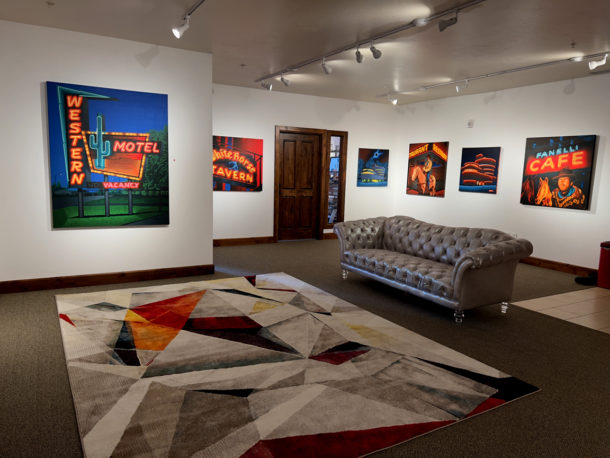
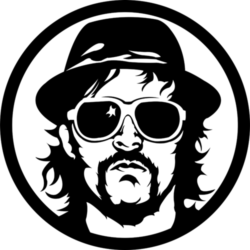
One comment
Comments are closed.